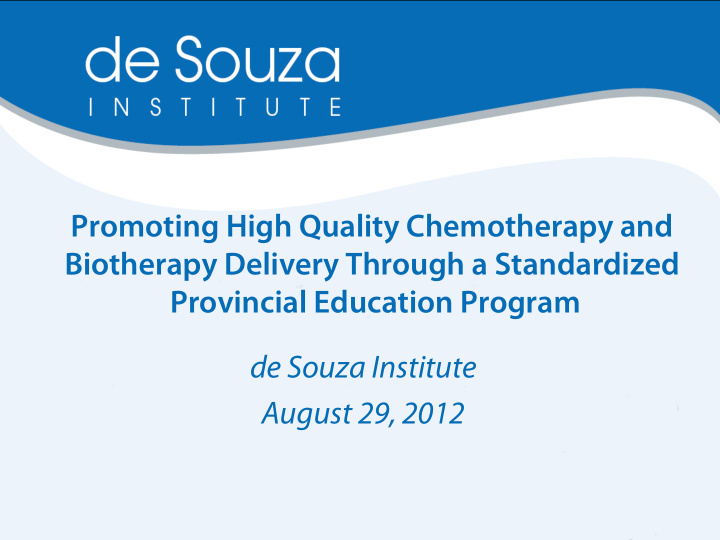



Promoting High Quality Chemotherapy and Biotherapy Delivery Through a Standardized Provincial Education Program de Souza Institute August 29, 2012
Goals for the Standardized Chemotherapy Course q Holistic patient-centred care, achieved through standardized chemotherapy and biotherapy education for all nurses in Ontario • Support patient safety and promote quality of care for all Ontarians • Support knowledge translation and evidence-based practice (EPB) q Integrate Cancer Care Ontario recommendations and guidelines
q Target Audience: • RNs providing care to cancer patients q Teaching modalities: • Two full day video conference classes (OTN) and one full day in person learning lab (2009/12) • Multiple modalities including eLearning system for baseline knowledge quiz, unit quiz and exit exam (2011) 3
Description of the Course (Facilitator led) Day 1 OTN Day 2 OTN • Course introduction • CINV • Wholistic care • Biotherapies • Intro to cancer and chemo/ • Administration principles biotherapy • Immediate adverse events • Chemotherapy agents • Safe handling • Toxicity management • Safety theories • Myelosuppression • • •
Outcome Evaluation q In order to receive a course completion certificate, a nurse must: • Participate fully in all course modules and in skills lab • Complete all unit quizzes • Achieve minimum 80% in a standardized exit exam q A local chemotherapy and biotherapy preceptorship is required for some participants
Evaluation Methods ( @ de Souza eLearning Center ) q Pre-reading materials and questions to get learners to a similar starting point q Baseline survey on learners’ demographic variables: age, gender, years of nursing /oncology experience, chemo experience, experience with specific types of cancer, etc q 13 unit quizzes and one exit exam q Learner feedback for program content, access and delivery effectiveness
Preceptorship after Course Completion • Preceptorship to be arranged with participant’s local health care facilities • de Souza Institute provides examples of online preceptorship evaluation tools and reflective practice tools (online) • de Souza Institute asks course participants to record preceptorship participation, and site educator(s) sign off the preceptorship via the eL earning system
Continuing Competency Requirements • Chemo course participants will need ongoing integration of knowledge, skills, and judgement in chemotherapy, necessary to meet professional practice standards in their practice role and specific setting. • de Souza recommends that the nurse participate in a yearly self-learning module, a self reflection and complete a self-assessment (exam) every year to maintain his/her competency for chemotherapy. Both are provided by de Souza Institute. • Certificate is provided for annual updates.
Building Capacity – Local Facilitators Facilitator standardized training: • take the standardized course • take facilitator training course • take yearly maintenance course • facilitate at least two classes per year
Course Completion Rate by LHIN Standardized Course led by de Souza Average completion rate: 78.1% 120 110 107 N (participants) 98 100 Participant Number N (Exam Pass) 84 78 80 69 61 60 42 39 40 31 30 24 22 20 9 - Completion rate is similar across the region, ranging from 66.7 - 89.9% Reasons for incompletion: did not complete all course requirements or failed exit exam
What Went Well q Contents are current, EBP, and easily adaptable to specific organizations q Safe handling procedure (hands-on) identifies common issues and helps (with) encourage consistency among organizations – “everyone learns the same information” q Integration of theory and practice is re-enforced via problem- solving, team work (practical application) in clinical skills lab q Contents integrates psychosocial elements in PBLs q Peer supports and validations helps to implement recommended standards of practice q Positive impact on nursing practice: patient safety, professional development, patient education, better care
What Processes/logistics Should be Enhanced? q Completion rate (80%) can be further improved q Combination of novice and experts helps to initiate a lot of discussion and information/practice sharing, networking opportunities, and accessibility. However, novice nurses found the content too “rushed” q Teleconference is a good alternative to classroom. However, three days away from unit remains a barrier to access
Proposed Next Step q Develop online curriculum, with possible pre-requisite, to strengthen the standardization of course content and improve homogeneity of learners’ readiness – expected implementation summer 2012 q The third day will remain as in person learning labs – to apply learning from the course q de Souza research team will conduct a systematic evaluation of eLearning, by comparing it with outcome from OTN learning. Local facilitators will receive support for the eLearning roll out. The project has been submitted for UHN ethics board for review and approval.
eLearning Course Demo • Module ten - safe handling hazardous drugs file:///D:/Safe%20Handling%20Module/index.html
Recommend
More recommend